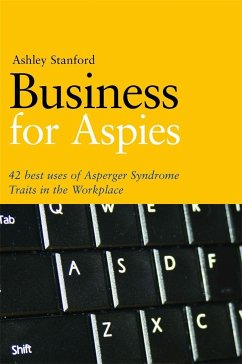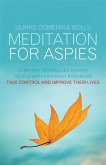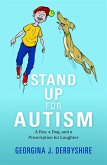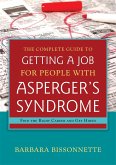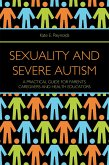Ashley Stanford
Business for Aspies
42 Best Practices for Using Asperger Syndrome Traits at Work Successfully
Ashley Stanford
Business for Aspies
42 Best Practices for Using Asperger Syndrome Traits at Work Successfully
- Broschiertes Buch
- Merkliste
- Auf die Merkliste
- Bewerten Bewerten
- Teilen
- Produkt teilen
- Produkterinnerung
- Produkterinnerung
Ashley Stanford addresses all of the issues that can arise once a person with AS secures employment, through the eyes of both employee and employer. Describing what might be expected of any employee, she offers helpful tips and workarounds not only to enable AS individuals achieve their fullest potential, but to take advantage of their strengths.
Andere Kunden interessierten sich auch für
![Meditation for Aspies Meditation for Aspies]() Ulrike Domenika BollsMeditation for Aspies28,99 €
Ulrike Domenika BollsMeditation for Aspies28,99 €![Stand Up for Autism Stand Up for Autism]() Georgina DerbyshireStand Up for Autism20,99 €
Georgina DerbyshireStand Up for Autism20,99 €![The Complete Guide to Getting a Job for People with Asperger's Syndrome The Complete Guide to Getting a Job for People with Asperger's Syndrome]() Barbara BissonnetteThe Complete Guide to Getting a Job for People with Asperger's Syndrome25,99 €
Barbara BissonnetteThe Complete Guide to Getting a Job for People with Asperger's Syndrome25,99 €![Sexuality and Severe Autism Sexuality and Severe Autism]() Kate E. ReynoldsSexuality and Severe Autism35,99 €
Kate E. ReynoldsSexuality and Severe Autism35,99 €![Connecting with Your Asperger Partner Connecting with Your Asperger Partner]() Louise WestonConnecting with Your Asperger Partner25,99 €
Louise WestonConnecting with Your Asperger Partner25,99 €![Teaching Theory of Mind Teaching Theory of Mind]() Kirstina OrdetxTeaching Theory of Mind51,99 €
Kirstina OrdetxTeaching Theory of Mind51,99 €![Evidence-Based Assessment in Asd (Autism Spectrum Disorder) Evidence-Based Assessment in Asd (Autism Spectrum Disorder)]() Kenneth J. AitkenEvidence-Based Assessment in Asd (Autism Spectrum Disorder)125,99 €
Kenneth J. AitkenEvidence-Based Assessment in Asd (Autism Spectrum Disorder)125,99 €-
-
-
Ashley Stanford addresses all of the issues that can arise once a person with AS secures employment, through the eyes of both employee and employer. Describing what might be expected of any employee, she offers helpful tips and workarounds not only to enable AS individuals achieve their fullest potential, but to take advantage of their strengths.
Hinweis: Dieser Artikel kann nur an eine deutsche Lieferadresse ausgeliefert werden.
Hinweis: Dieser Artikel kann nur an eine deutsche Lieferadresse ausgeliefert werden.
Produktdetails
- Produktdetails
- Verlag: Jessica Kingsley Publishers
- Seitenzahl: 240
- Erscheinungstermin: 15. Februar 2011
- Englisch
- Abmessung: 228mm x 154mm x 17mm
- Gewicht: 402g
- ISBN-13: 9781849058452
- ISBN-10: 1849058458
- Artikelnr.: 31383533
- Herstellerkennzeichnung
- Libri GmbH
- Europaallee 1
- 36244 Bad Hersfeld
- gpsr@libri.de
- Verlag: Jessica Kingsley Publishers
- Seitenzahl: 240
- Erscheinungstermin: 15. Februar 2011
- Englisch
- Abmessung: 228mm x 154mm x 17mm
- Gewicht: 402g
- ISBN-13: 9781849058452
- ISBN-10: 1849058458
- Artikelnr.: 31383533
- Herstellerkennzeichnung
- Libri GmbH
- Europaallee 1
- 36244 Bad Hersfeld
- gpsr@libri.de
Ashley Stanford has worked as a technical writer for 16 years and is the CEO of a successful computer software company. She is the author of Asperger Syndrome and Long-Term Relationships, also published by Jessica Kingsley Publishers. She lives in Berkeley, California.
Preface. Introduction. 1. Baseline Starting Point for Building Your Career.
Many Undiscovered Talents . Underestimating Aspies. Does Asperger Syndrome
Limit You? The Flip Side of the Coin. 2. Executive Function. Organization
Matters - Your Desk, Your Brain. When the Solution Is Avoiding the Problem.
Now You See It; Now You Don't. Organization of Events. Organization of
Tasks. Beyond Organization - Maslow's Pyramid for Aspies. 3. Social
Interaction on the Job. Best Practice 1: Engaged and Safe. Best Practice 2:
The Easier Friendship - Co-Workers. 4. Eye Contact and Reading Faces at
Work. Best Practice 3: When Less Is More. Best Practice 4: Relaxing Your
Eyes - Face Muting. Best Practice 5: Training Your Eyes - Mapping the Blank
Face. Best Practice 6: The No Face-Time Flexibility Rule. Best Practice 7:
Building Skills for Ultimate Flexibility - Removing the Pressure for
In-Person Work. 5. Body Postures and Gestures on the Job. Best Practice 8:
"Quiet" Posture. Best Practice 9: Mimic Other Successful Professionals.
Best Practice 10: Professional Restrictions to the Rescue. 6. The People
You Work With . Best Practice 11: The Back-Stabber, the Drama Queen, and
the Glory Hog. Best Practice 12: Your Relationship with Your Boss. Best
Practice 13: "Get a Life!" 7. Do I Enjoy My Job? Best Practice 14: Make
Your Enjoyment Obvious. Best Practice 15: Test Check for Happiness on the
Job. Best Practice 16: Avoiding the Biggest Pitfall - Abdicating Free Will.
Best Practice 17: Career Trajectory. 8. Your Most Valuable Traits . Best
Practice 18: Know Your Strengths. Best Practice 19: How You Help Your Team
Focus. Best Practice 20: The One Who Retains His Job When the Rest Are
Fired. Best Practice 21: Respecting Yourself . 9. Your Position in the
Company - Building It and Keeping It. Best Practice 22: Behaving Like the
Boss, i.e. Someone Well-Paid. Best Practice 23: Ask for Help - The 42 Best
Practice Notebook. Best Practice 24: Brainspace. Best Practice 25: Securing
Your Job and Scoring a Raise. Best Practice 26: Motivation Matters. Best
Practice 27: The Halo Effect - Avoid It. 10. Issues of Flexibility and
Routine. Best Practice 28: Stability . Best Practice 29: Loyalty. Best
Practice 30: Trust. Best Practice 31: Keeping the Machine Running. 11Your
Sensory System at Work. Best Practice 32: EveryBODY Needs Something
Different. Best Practice 33: Building Support. Best Practice 34: Channeling
Sensory Needs into Career Needs. 12. Unique Aspie Preoccupations on the
Job. Best Practice 35: The Manager and the Builder. Best Practice 36:
Neurotypical Meetings and Aspie Survival. Best Practice 37: Well-Rounded Is
Not the Goal - Let Your Freak Flag Fly. 13. Who You Are at Work. Best
Practice 38: The Thoughtful Pause, a Sign of Wisdom. Best Practice 39:
Shift Expectations Internally and at Work . Best Practice 40: Creating a
Trustworthy Persona at Work. Best Practice 41: When "Othering" Happens at
Work. Best Practice 42: Asserting Your Opinion Confidently Without Being
Labeled Narcissistic or Otherwise Unpleasant. 14. Safety, Survival, and
Ultimate Success. The Safety Point. Survival Toolkit Top 10. Aspie Bill of
Rights - General. Aspie Bill of Rights - Workplace. Summary. References.
Further Reading. About the Author. Index
Many Undiscovered Talents . Underestimating Aspies. Does Asperger Syndrome
Limit You? The Flip Side of the Coin. 2. Executive Function. Organization
Matters - Your Desk, Your Brain. When the Solution Is Avoiding the Problem.
Now You See It; Now You Don't. Organization of Events. Organization of
Tasks. Beyond Organization - Maslow's Pyramid for Aspies. 3. Social
Interaction on the Job. Best Practice 1: Engaged and Safe. Best Practice 2:
The Easier Friendship - Co-Workers. 4. Eye Contact and Reading Faces at
Work. Best Practice 3: When Less Is More. Best Practice 4: Relaxing Your
Eyes - Face Muting. Best Practice 5: Training Your Eyes - Mapping the Blank
Face. Best Practice 6: The No Face-Time Flexibility Rule. Best Practice 7:
Building Skills for Ultimate Flexibility - Removing the Pressure for
In-Person Work. 5. Body Postures and Gestures on the Job. Best Practice 8:
"Quiet" Posture. Best Practice 9: Mimic Other Successful Professionals.
Best Practice 10: Professional Restrictions to the Rescue. 6. The People
You Work With . Best Practice 11: The Back-Stabber, the Drama Queen, and
the Glory Hog. Best Practice 12: Your Relationship with Your Boss. Best
Practice 13: "Get a Life!" 7. Do I Enjoy My Job? Best Practice 14: Make
Your Enjoyment Obvious. Best Practice 15: Test Check for Happiness on the
Job. Best Practice 16: Avoiding the Biggest Pitfall - Abdicating Free Will.
Best Practice 17: Career Trajectory. 8. Your Most Valuable Traits . Best
Practice 18: Know Your Strengths. Best Practice 19: How You Help Your Team
Focus. Best Practice 20: The One Who Retains His Job When the Rest Are
Fired. Best Practice 21: Respecting Yourself . 9. Your Position in the
Company - Building It and Keeping It. Best Practice 22: Behaving Like the
Boss, i.e. Someone Well-Paid. Best Practice 23: Ask for Help - The 42 Best
Practice Notebook. Best Practice 24: Brainspace. Best Practice 25: Securing
Your Job and Scoring a Raise. Best Practice 26: Motivation Matters. Best
Practice 27: The Halo Effect - Avoid It. 10. Issues of Flexibility and
Routine. Best Practice 28: Stability . Best Practice 29: Loyalty. Best
Practice 30: Trust. Best Practice 31: Keeping the Machine Running. 11Your
Sensory System at Work. Best Practice 32: EveryBODY Needs Something
Different. Best Practice 33: Building Support. Best Practice 34: Channeling
Sensory Needs into Career Needs. 12. Unique Aspie Preoccupations on the
Job. Best Practice 35: The Manager and the Builder. Best Practice 36:
Neurotypical Meetings and Aspie Survival. Best Practice 37: Well-Rounded Is
Not the Goal - Let Your Freak Flag Fly. 13. Who You Are at Work. Best
Practice 38: The Thoughtful Pause, a Sign of Wisdom. Best Practice 39:
Shift Expectations Internally and at Work . Best Practice 40: Creating a
Trustworthy Persona at Work. Best Practice 41: When "Othering" Happens at
Work. Best Practice 42: Asserting Your Opinion Confidently Without Being
Labeled Narcissistic or Otherwise Unpleasant. 14. Safety, Survival, and
Ultimate Success. The Safety Point. Survival Toolkit Top 10. Aspie Bill of
Rights - General. Aspie Bill of Rights - Workplace. Summary. References.
Further Reading. About the Author. Index
Preface. Introduction. 1. Baseline Starting Point for Building Your Career.
Many Undiscovered Talents . Underestimating Aspies. Does Asperger Syndrome
Limit You? The Flip Side of the Coin. 2. Executive Function. Organization
Matters - Your Desk, Your Brain. When the Solution Is Avoiding the Problem.
Now You See It; Now You Don't. Organization of Events. Organization of
Tasks. Beyond Organization - Maslow's Pyramid for Aspies. 3. Social
Interaction on the Job. Best Practice 1: Engaged and Safe. Best Practice 2:
The Easier Friendship - Co-Workers. 4. Eye Contact and Reading Faces at
Work. Best Practice 3: When Less Is More. Best Practice 4: Relaxing Your
Eyes - Face Muting. Best Practice 5: Training Your Eyes - Mapping the Blank
Face. Best Practice 6: The No Face-Time Flexibility Rule. Best Practice 7:
Building Skills for Ultimate Flexibility - Removing the Pressure for
In-Person Work. 5. Body Postures and Gestures on the Job. Best Practice 8:
"Quiet" Posture. Best Practice 9: Mimic Other Successful Professionals.
Best Practice 10: Professional Restrictions to the Rescue. 6. The People
You Work With . Best Practice 11: The Back-Stabber, the Drama Queen, and
the Glory Hog. Best Practice 12: Your Relationship with Your Boss. Best
Practice 13: "Get a Life!" 7. Do I Enjoy My Job? Best Practice 14: Make
Your Enjoyment Obvious. Best Practice 15: Test Check for Happiness on the
Job. Best Practice 16: Avoiding the Biggest Pitfall - Abdicating Free Will.
Best Practice 17: Career Trajectory. 8. Your Most Valuable Traits . Best
Practice 18: Know Your Strengths. Best Practice 19: How You Help Your Team
Focus. Best Practice 20: The One Who Retains His Job When the Rest Are
Fired. Best Practice 21: Respecting Yourself . 9. Your Position in the
Company - Building It and Keeping It. Best Practice 22: Behaving Like the
Boss, i.e. Someone Well-Paid. Best Practice 23: Ask for Help - The 42 Best
Practice Notebook. Best Practice 24: Brainspace. Best Practice 25: Securing
Your Job and Scoring a Raise. Best Practice 26: Motivation Matters. Best
Practice 27: The Halo Effect - Avoid It. 10. Issues of Flexibility and
Routine. Best Practice 28: Stability . Best Practice 29: Loyalty. Best
Practice 30: Trust. Best Practice 31: Keeping the Machine Running. 11Your
Sensory System at Work. Best Practice 32: EveryBODY Needs Something
Different. Best Practice 33: Building Support. Best Practice 34: Channeling
Sensory Needs into Career Needs. 12. Unique Aspie Preoccupations on the
Job. Best Practice 35: The Manager and the Builder. Best Practice 36:
Neurotypical Meetings and Aspie Survival. Best Practice 37: Well-Rounded Is
Not the Goal - Let Your Freak Flag Fly. 13. Who You Are at Work. Best
Practice 38: The Thoughtful Pause, a Sign of Wisdom. Best Practice 39:
Shift Expectations Internally and at Work . Best Practice 40: Creating a
Trustworthy Persona at Work. Best Practice 41: When "Othering" Happens at
Work. Best Practice 42: Asserting Your Opinion Confidently Without Being
Labeled Narcissistic or Otherwise Unpleasant. 14. Safety, Survival, and
Ultimate Success. The Safety Point. Survival Toolkit Top 10. Aspie Bill of
Rights - General. Aspie Bill of Rights - Workplace. Summary. References.
Further Reading. About the Author. Index
Many Undiscovered Talents . Underestimating Aspies. Does Asperger Syndrome
Limit You? The Flip Side of the Coin. 2. Executive Function. Organization
Matters - Your Desk, Your Brain. When the Solution Is Avoiding the Problem.
Now You See It; Now You Don't. Organization of Events. Organization of
Tasks. Beyond Organization - Maslow's Pyramid for Aspies. 3. Social
Interaction on the Job. Best Practice 1: Engaged and Safe. Best Practice 2:
The Easier Friendship - Co-Workers. 4. Eye Contact and Reading Faces at
Work. Best Practice 3: When Less Is More. Best Practice 4: Relaxing Your
Eyes - Face Muting. Best Practice 5: Training Your Eyes - Mapping the Blank
Face. Best Practice 6: The No Face-Time Flexibility Rule. Best Practice 7:
Building Skills for Ultimate Flexibility - Removing the Pressure for
In-Person Work. 5. Body Postures and Gestures on the Job. Best Practice 8:
"Quiet" Posture. Best Practice 9: Mimic Other Successful Professionals.
Best Practice 10: Professional Restrictions to the Rescue. 6. The People
You Work With . Best Practice 11: The Back-Stabber, the Drama Queen, and
the Glory Hog. Best Practice 12: Your Relationship with Your Boss. Best
Practice 13: "Get a Life!" 7. Do I Enjoy My Job? Best Practice 14: Make
Your Enjoyment Obvious. Best Practice 15: Test Check for Happiness on the
Job. Best Practice 16: Avoiding the Biggest Pitfall - Abdicating Free Will.
Best Practice 17: Career Trajectory. 8. Your Most Valuable Traits . Best
Practice 18: Know Your Strengths. Best Practice 19: How You Help Your Team
Focus. Best Practice 20: The One Who Retains His Job When the Rest Are
Fired. Best Practice 21: Respecting Yourself . 9. Your Position in the
Company - Building It and Keeping It. Best Practice 22: Behaving Like the
Boss, i.e. Someone Well-Paid. Best Practice 23: Ask for Help - The 42 Best
Practice Notebook. Best Practice 24: Brainspace. Best Practice 25: Securing
Your Job and Scoring a Raise. Best Practice 26: Motivation Matters. Best
Practice 27: The Halo Effect - Avoid It. 10. Issues of Flexibility and
Routine. Best Practice 28: Stability . Best Practice 29: Loyalty. Best
Practice 30: Trust. Best Practice 31: Keeping the Machine Running. 11Your
Sensory System at Work. Best Practice 32: EveryBODY Needs Something
Different. Best Practice 33: Building Support. Best Practice 34: Channeling
Sensory Needs into Career Needs. 12. Unique Aspie Preoccupations on the
Job. Best Practice 35: The Manager and the Builder. Best Practice 36:
Neurotypical Meetings and Aspie Survival. Best Practice 37: Well-Rounded Is
Not the Goal - Let Your Freak Flag Fly. 13. Who You Are at Work. Best
Practice 38: The Thoughtful Pause, a Sign of Wisdom. Best Practice 39:
Shift Expectations Internally and at Work . Best Practice 40: Creating a
Trustworthy Persona at Work. Best Practice 41: When "Othering" Happens at
Work. Best Practice 42: Asserting Your Opinion Confidently Without Being
Labeled Narcissistic or Otherwise Unpleasant. 14. Safety, Survival, and
Ultimate Success. The Safety Point. Survival Toolkit Top 10. Aspie Bill of
Rights - General. Aspie Bill of Rights - Workplace. Summary. References.
Further Reading. About the Author. Index

